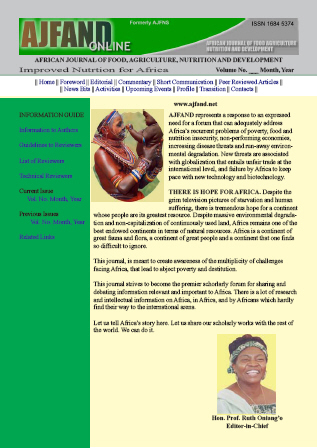
|
African Journal of Food, Agriculture, Nutrition and Development
Rural Outreach Program
ISSN: 1684-5358
EISSN: 1684-5358
Vol. 20, No. 2, 2020, pp. 15455-15473
|
 Bioline Code: nd20019
Bioline Code: nd20019
Full paper language: English
Document type: Research Article
Document available free of charge
|
|
|
African Journal of Food, Agriculture, Nutrition and Development, Vol. 20, No. 2, 2020, pp. 15455-15473
| en |
CHARACTERIZATION OF CARCASS AND PREFERENCE OF CONSUMERS FOR MEAT FROM FOUR STRAINS OF THE TANZANIA SMALL EAST AFRICAN GOATS
Semuguruka, YD; Msalya, G; Nguluma, AS & Chenyambuga, SW
Abstract
Goats are an integral part of farming systems in rural communities of Tanzania and are
second in importance after cattle in the provision of meat, milk, and income. It was
estimated that there were 18 million goats in Tanzania in 2018 and the majority (about
98%) belonged to the Small East African (SEA) breed. The SEA goats are characterized
by low productivity due to their inherently low genetic potential for meat and milk
leading to low profitability. It is important to design sustainable programmes for
increasing productivity of indigenous goats and the first step is to compile status with
regard to productivity and to assess market-oriented characteristics for these animals.
The aims of this study were: to evaluate carcass characteristics of meat from four strains
of the SEA goats namely Gogo, Pare, Sonjo as well as Sukuma, and to assess the
preference of consumers for goat meat and meat cuts. Forty eight goats (12 per strain)
were involved in this study. The meat was dissected into lean, bone, subcutaneous fat as
well as standard joints, and these parts were weighed or measured to obtain the lengths.
Longissimus dorsi was sampled from the carcass to determine quality using proximate
analysis. Also, a survey was conducted to determine the prices of meat cuts and
preferences of consumers using a questionnaire. Averages were compared using the
General Linear Model (GLM) procedure of the statistical analysis system. Survey data
were coded and analyzed using Statistical Package for Social Sciences (SPSS). Test of
significance was based on 5%. The composition of meat was 65.2 to 67% lean, 23.5 to
25.7% bone and 8.4 to 10.7% fat. Gogo strain had heaviest carcasses (10.3±0.45kg).
Dressing Percentage (DP) ranged from 42.1 to 43.5% and was not significant among
strains. Carcass Length (CL), Chest Depth (CD), length of Hind Legs (HLL) and leg
circumference were significant among strains and CD was associated with the weight of
the carcass. Fore and hind parts as well as ribs comprised 60% lean. Crude protein and
ash were significant among strains whereas dry matter and fat were not significant. The
hind leg was most preferred (52.5% respondents) because of more meat although was the
most priced part (9798±385 Tanzanian shillings about 4.3US$). In conclusion, the SEA
strains evaluated in this study contained more meat and less bone and fat; there are
variations in characteristics and quality of meat among the strains, and consumers prefer
the more meaty parts.
Keywords
Indigenous goats; Carcass weight; Carcass composition; Meat quality
|
| |
© Copyright [2020] - African Journal of Food, Agriculture, Nutrition and Development
Alternative site location: http://www.ajfand.net/
|
|
